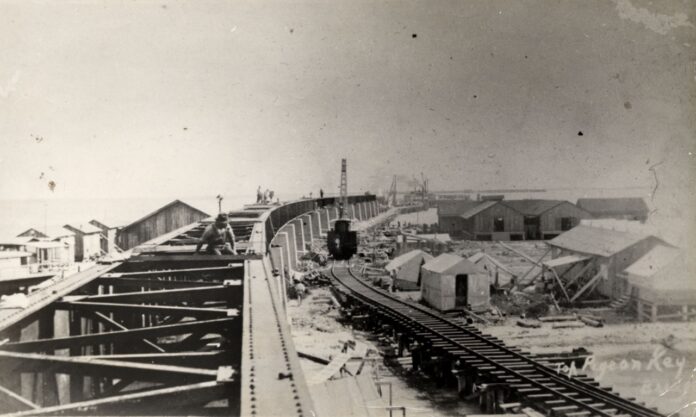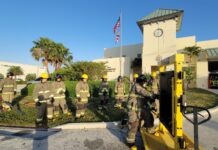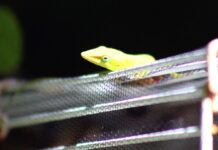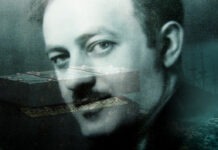
In the Florida Keys, we all have our favorite islands. My favorite, Indian Key, has an incredible story, and I have written an inordinate number of columns about it over the years. This column, however, is about Kelly McKinnon’s favorite island.
McKinnon is the executive director at the Pigeon Key Foundation, and his favorite island, believe it or not, is Pigeon Key, located under the old Seven Mile Bridge in the Middle Keys.
On early Spanish charts, the island McKinnon is lucky enough to call home was identified as Cayo Paloma. Paloma is the Spanish word for pigeon, and the story behind the name suggests the island was once home to large flocks of pigeons. The namesake bird was the distinctive white-crowned pigeon. As it can be imagined, the slate-gray feathered bird has a crown of white feathers covering its head. The pigeons are indigenous to extreme South Florida and the Keys, the Bahamas, the Greater and Lesser Antilles islands, southeastern Mexico, and Central America — and once, they called Pigeon Key home.
They are a skittish species and should be, as they were relentlessly hunted in the late 19th and early 20th centuries. Today, the fast-flying birds can be seen zooming over the tops of the tropical hammocks they call home. While they are no longer hunted in the Keys and South Florida, their populations are threatened by the destruction of the hammocks and the loss of the fruit-bearing hardwood trees on which they feed.
Pigeon Key, however, is not remembered for its birds — though it does seem to have a history with them. A man named Otto Stellrecht, born in 1863 in Germany, immigrated to America at 19. In 1892, he came to Florida, and three years later, in 1895, Stellrecht moved to the Torch Keys, about 25 miles away from Key West. Family stories say that he farmed a grove of Key lime trees while there. They also suggest that he raised turkeys on Pigeon Key.
What Pigeon Key is best remembered for, however, is its connection to the building of the Key West Extension of Henry Flagler’s Florida East Coast Railway. Because of its placement within that 7-mile watery gap between Marathon and the Lower Keys, the island was viewed as a potential base of operations during the construction of the series of four bridges connecting the two sets of islands.
In 1907, the 5-acre Pigeon Key was surveyed by railroad engineers and determined to be the ideal location for a construction campsite. After the island was cleared of its hardwood hammock, railroad workers built three dormitories, a large mess hall, a warehouse, offices, a bakery, a commissary and an infirmary tent.
Because the small island became inundated with workers, a fourth dormitory was built, and tents were erected to house the more than 400 people living on the island during those peak construction periods. Unlike the vast majority of island communities outside of Key West, one luxury the workers had was electricity to light the buildings — F.E.C. Railway generators powered it.
The day before the passenger train carrying Henry Flagler shook, rattled and roared across Key West and steamed into the southernmost terminal for the first time, the Jan. 21, 1912, edition of the Indianapolis Sunday Star printed a story mentioning Pigeon Key: “The camps are in charge of a resident or division engineer with the one at Pigeon Key presently the most active. At high tide, Pigeon Key is about two acres in extent and perhaps three acres at low tide. There are four bunkhouses, each designed to hold 64 men; one of them for the foremen, who are housed apart from the laborers. Each has a reading room with good lights. Good mattresses are provided on standard double-decked bunks, with plenty of clean bedclothes; all laundry work being done by the company. Once a week all beds are washed and thoroughly disinfected to keep any parasites from getting a start.”
Pigeon Key and the rest of the F.E.C. right-of-way were sold to the state after the 1935 Labor Day Hurricane ended the railroad’s run. Eventually, Monroe County was given possession of the island where, today, the old wooden railroad buildings stand like a sort of ghost town — but a kind of living ghost town.
The island was listed as a National Historic Landmark in 1990, and two years later, the Pigeon Key Foundation was formed to “protect the island’s long-standing history from the Henry Flagler era.”
Today, visiting the island is a bit like stepping back in time — but also, because of the foundation’s mission, those visiting the island are offered the opportunity to peek into the future.
In addition to preserving history, one of the foundation’s missions is to “educate our youth through marine science curricula and research.”
If you have not visited the island, step back in time, walk the grounds and see the railroad buildings dating back to 1908. The island’s museum is filled with historic photographs, artifacts and stories revealing a more profound history of this amazing island. Guided tours are available. For more information about the Pigeon Key Foundation and touring the island, visit www.pigeonkey.net.




















